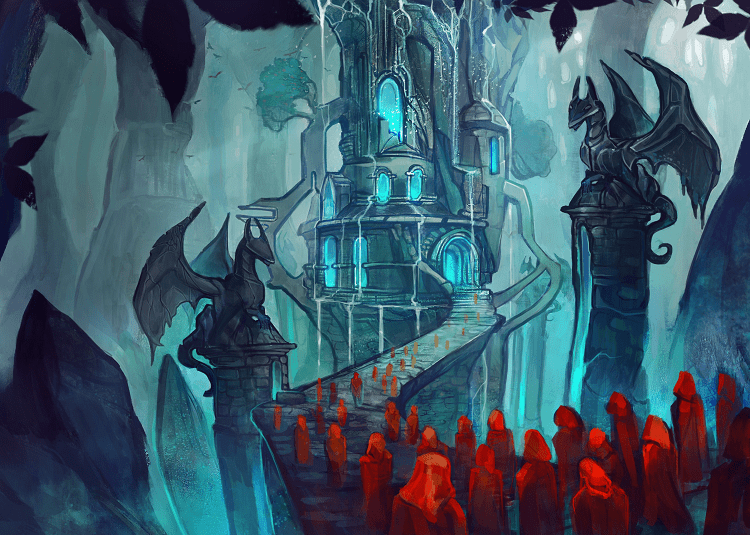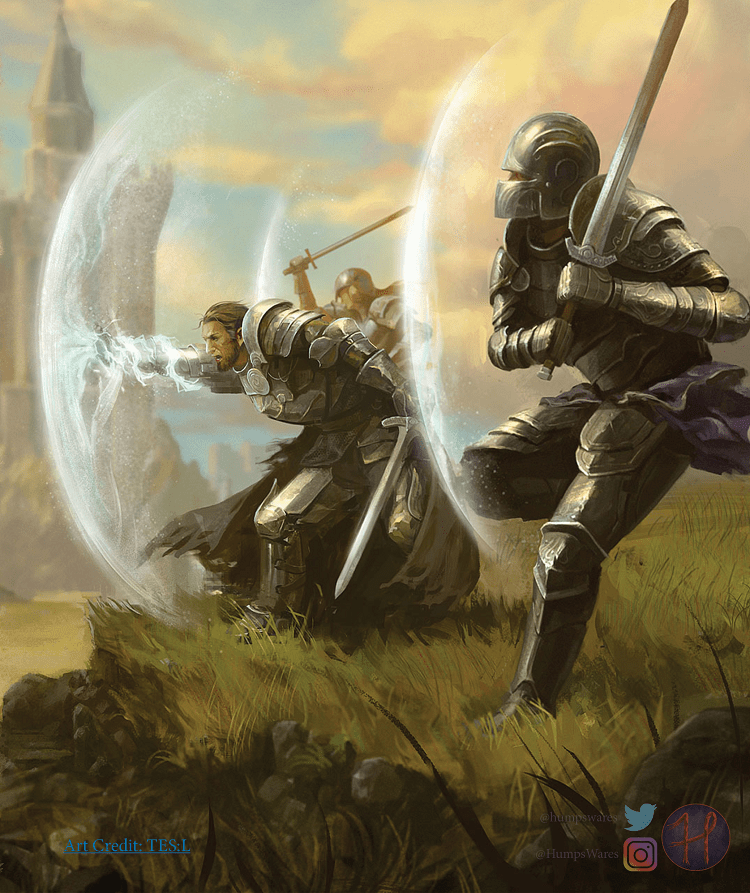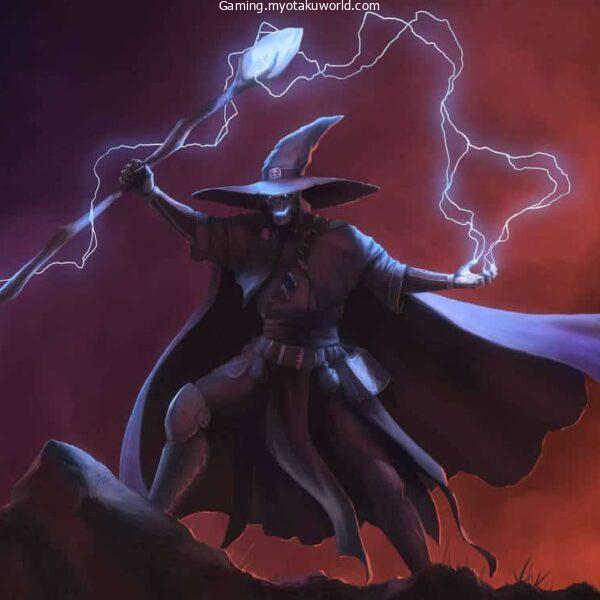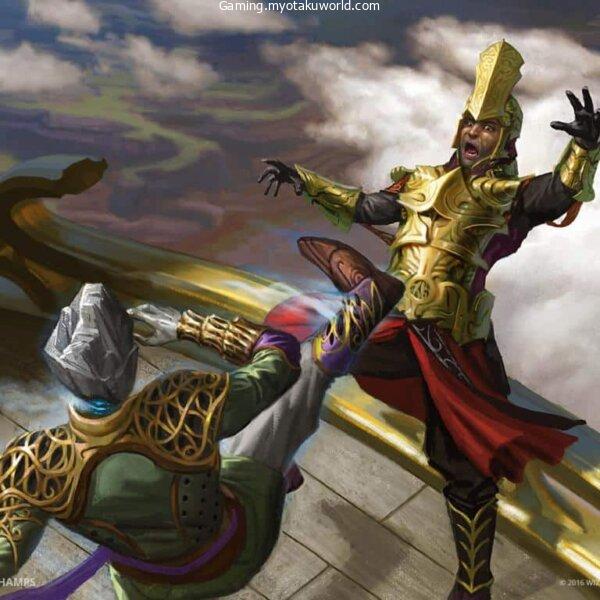You ward a creature within range against attack. Until the spell ends, any creature who targets the warded creature with an attack or a harmful spell must first make a Wisdom saving throw.
On a failed save, the creature must choose a new target or lose the attack or spell. This spell doesn’t protect the warded creature from area effects, such as the explosion of a fireball.
If the warded creature makes an attack, casts a spell that affects an enemy, or deals damage to another creature, this spell ends.
What Does Sanctuary Do?
Sanctuary protects one ally within 30 feet. If an enemy tries to attack or cast a spell targeting that ally, they first have to make a Wisdom saving throw.
On a failure, they have to redirect that same attack or spell at a new valid target or lose the attack or spell.
Sanctuary offers no protection from area-of-effect spells — it only works when directly targeted.
If the affected creature makes an attack, casts a spell that affects an enemy, or damages a creature, Sanctuary ends.
Sanctuary lasts for one minute. The two really special things about Sanctuary are that its casting time is a bonus action and it requires no concentration to maintain.
This combination of great action economy and no-hassle upkeep is what makes Sanctuary worth looking at twice.
All the Little Details
For one thing, this is not a concentration spell, and for another, this is a 1st level spell. As a whole, this is what Sanctuary does.
| Casting time | 1 Bonus Action |
| Range | 30 ft |
| Target | A Creature within range |
| Components | Verbal, Somatic, Material |
| Duration | 1 Minute |
It is a defensive spell that keeps away one single creature. If an enemy fails a Wisdom saving throw, it must either attack a different creature than the one being warded or stop attacking.
The impact lasts as long as the spell does or until the creature attacks an enemy or casts a spell that affects an enemy.
A simple spell that cannot be broken under any circumstances.
Usage

As the last paragraph showed, this spell isn’t very fancy or hard to do. But unlike spells that hurt, this one is easy enough to use that we can set up events to take advantage of it.
Of course, you can use harmful spells in any setting, but this one has to be done in a certain way.
Most of the time, you should cast this spell after you attack or cast magic that does damage. If you’re going to cast on a friend, it’s best to make sure they’ve already taken their turn or that they’re not going to attack.
You want this spell to be as powerful as possible, so making sure the target doesn’t break the spell is very important. If not, there are better spells you can cast with that spell spot.
I usually cast this when I plan to take a lot of attacks from enemies or jump into a group of enemies to confuse them. This spell usually doesn’t work on large or legendary creatures because they have high saves or legendary resistance that lets them blow right through it.
In more specific situations, like when a lot of healing is needed or when my damage won’t hit or won’t do much damage, I choose to cast Sanctuary and start helping out instead.
But a note about the first one does apply to the second one. Surprisingly, this spell is still useful at higher levels because monsters and animals that attack your party as a group usually have trouble making a Wisdom saving throw against a caster who is well-equipped.
Plus, it’s a bonus action that lets you use your action for something else. This means you can use it to interact with the map or try to set up for your friends.
Fun fact: You can cast this spell on a downed friend if you think that getting closer to them or healing them would be a bad idea, since they are still creatures even if they don’t know it. Since there is no agreement clause, you can also use this spell to hurt enemies and people you don’t know.
Even though this is a leveled spell and you can’t cast another leveled spell as your action, here are some other things you can do instead of wasting your time.
The Action Economy is in Shambles
Using your action before casting this spell, whether to hit or do something else, never goes wrong. This part is more for if you decide to cast this first and then use your action, maybe to avoid attacks of opportunity or to get through holding actions with a small investment.
You can use your main action to make anything from healing potions to traps and everything in between. Even if the item you use hurts an enemy, it would not break the Sanctuary because it is neither an attack nor a spell.
This is a great way to set up a defense or heal friends when you are running out of spell slots. You can even use it to get potions with more unique benefits that could change the next turn.
You can also use the dodge move, which makes it harder for them to hit you when they do. It is a second line of defense, and tanking makes it even harder for enemies to try to kill you.
With a high armor class, an attack roll penalty, and a saving throw to try an attack, it seems pointless to try to hurt you. It could make enemies avoid you all together, so make sure you’re the only one they can fight or let your allies know what could happen.
You could use this time to help downed party members get back up and move them to a safe place away from abilities with large areas of effect. Try skill checks to figure something out or active awareness checks to find an enemy or device hiding in plain sight.
Even though it has nothing to do with fighting, being aware of the whole situation could help your party get out of a bad situation or, worse, a room where they are stuck.
Lastly, you can do the move “help.” This would give the next ally you select an advantage on the next attack roll they make against an enemy within 5 feet of you or on the next skill check they make, as long as they do it before your next turn.
The effectiveness of these actions relies on what you have and your stats, but in general, they are good alternatives. You can still dash and withdraw if you want to, but unless you are trying to get somewhere quickly, walking by should be fine.
Who Can Cast it

You may know that all clerics can cast this spell. However, there are a few classes wherein their subclasses can also pick this skill up.
Clerics (Domain of Peace)
When a cleric learns this ability at level one, they can choose to have it ready for them. It works for them as a way to protect themselves or others.
Since Clerics would probably be healing or helping the party, they wouldn’t break the spell, giving them room to move around and not get hit.
On top of the benefits from Sanctuary, it helps that Clerics have a high Wisdom number and sometimes a high AC. This makes them even more tanky.
Clerics in the Domain of Peace deserve special attention because this spell is part of the Domain powers, so it is always ready.
Artificers
The Eberron class is a new one that D&D has added to its list. This half-caster class is more like a three-quarters-caster than anything else.
Depending on their subclass, they are good at dealing damage, being a tank, or taking charge. In all states, they rarely attack directly, so having this skill is a good way to stay safe since they are still half-casters and not tanky martial classes.
This would mean, of course, that you are letting your turrets or robot partner do the damage while you stay and help it with spells and buffs. Sanctuary would be less useful for the tanky subclass because they need their actions and bonus actions to keep fighting or stay alive in contact.
Paladin With Oath of Devotion, Oath of Redemption
We’re getting into subclasses now, since Paladins don’t get this power by default. Instead, this becomes the promise spell for the Oaths of Devotion and Redemption. This is always ready and can be cast at any time, but it doesn’t take up a spot for a ready spell.
It makes sense, since the point of Devotion is to protect yourself so you can help the cause and the point of Redemption is to give others a second chance to help their cause. It’s nice to see the way the game works and how it feels work together.
Warlock of the Genie
Since Tasha’s Cauldron of Everything changed the game so much, you can understand how powerful this pact is. Genie Warlocks must choose or be picked by a certain type of genie. The Dao genie, also called the Earth Elemental genie, is the one that gives Sanctuary.
It makes sense that you can protect yourself when you are connected with the Dao, since the earth has always been used to represent stability and a strong defense in most media.
Monk of Way of the Open Hand
Okay, listen to me. Monks don’t have Sanctuary per se, but when they learn the Way of the Open Hand, they get a skill that gives them some of its benefits. Tranquility, its level 11 skill, lets them get the effects of a Sanctuary spell until their next long rest.
I think it would be fair if it had a longer length and came into play much later in the game.
Is it Good

I’d say it depends on how well they play. Compared to other spells, it doesn’t get used as often, but when it does, it really does what it says it does.
It’s good because it can be made quickly and is not too concentrated at the same time. This makes it stand out from the other defensive spells because it can keep up with the action in a game like D&D, which is built on offense.
Its effect is strong against groups of enemies, but it’s not as good against big enemies with big stat pools. But the spell gives a safety net that no other spell can, because it can make an enemy miss an attack or lose an action.
On top of that, it lasts as long as you don’t attack. In battle, a minute is ten rounds, which is a lot of time for things to change.
I have a tip for you, DMs: think about how smart the monsters you’re running are. For example, zombies wouldn’t realize how hard it is to attack a target, so they might just scream at it without getting anywhere. A mage or a bandit, on the other hand, might see that something is up and avoid the protected target.
I’d say it’s good, since it’s a 1st-level spell that doesn’t require focus and can be cast in one bonus action. This makes it a powerful defensive spell that can be used in the middle of a fight. It has some flaws, though, so I would give it an 8 out of 10.
Combos
You can use this spell in many different ways, from simple placement to more complicated builds and sequences. I won’t list each one by name, but I will list the more general things you can do under Sanctuary.
Summoning
Since Sanctuary won’t break unless the creature it’s protecting attacks or casts a card that does damage, you can call a creature and make it attack someone else.
It says that “casting a spell that affects another creature” will break it, but calling doesn’t affect another creature; it creates a creature.
Sanctuary is also not broken if you tell another creature to attack, so Artificers with their turrets or any summoning power works great.
Illusions
This is a bit more detailed in how it is said. As a general rule, an illusion is fine if it affects a place rather than a person.
But the more it gets close to hurting an enemy, the more it’s up to the DM to decide how it works. Minor Illusion, Silent Image, and Hallucinatory Terrain are all illusion spells that are sure to work.
Check to see if the magic hurts the person casting it or makes them less able to do it. If this is true, Sanctuary will be destroyed.
Maintaining Spell Effect
These would be spells like “Dominate,” “Effects that are already in play and need action to keep going,” and “Concentration spells that weaken the target.”
Even though it seems illogical to keep these up, they have already missed their chance to break Sanctuary, so it’s fine to keep concentrating on them.
If the spell does damage, it would, in my view, break the Sanctuary. Here, we enter a tricky area called “Rules as Written” (RAW) vs. “Rules as Intended” (RAI).
By the letter of the law, once the spell is cast, Sanctuary has no effect on it, even if it does regular damage. But, RAI, if you did something bad, it would break the peace.
In the end, it’s up to each DM to decide what to do.
Buffing

You can still use buff spells after Sanctuary because they help “friendly” animals instead of enemies. If you want to trick a boss with Haste, it won’t work because it is a “enemy.” Just like that.
Tanking
There are many things you can do to stay alive longer and keep enemies away. You could, for example, fix yourself, raise your AC, or take the dodge action. It feels like the last fight as you watch swarms of enemies try to attack you over and over again but fail.
Special Mentions
- Abjuration Wizard
- Since Sanctuary is an Abjuration spell, your Arcane Ward would refill by casting it.
- Lore Bards
- RAW and RAI agree that Cutting Words is neither an attack nor a spell, so even if you insult enemies to the point of missing your allies, it still flies under Sanctuary’s restrictions.
FAQs
Can You Cast Sanctuary More than Once?
Yes, so long as you do not cast it on yourself. In D&D, you cannot stack spells with the same name on the same target. However, Sanctuary can be cast on other creatures while maintaining each previous cast for one minute.
Does Grapple Break Sanctuary?
Yes, if you initiate it after casting the spell; no, if you are maintaining a grapple against a creature after casting the spell. To start a grapple, you must make an attack roll against the target creature, which would break the restriction on Sanctuary.
Do Spirit Guardians Break Sanctuary?
es, it does if you cast it pre-Sanctuary; no, it does not if you cast it post-Sanctuary. Spirit Guardians do damage upon summoning and every succeeding turn afterward. So it would break the restriction on Sanctuary.
How can I obtain the Sanctuary spell in 5th Edition D&D?
The Sanctuary spell can be obtained by characters who have the ability to cast spells and have it available in their class’s spell list. Some classes, such as clerics, paladins, or certain types of wizards, may automatically have access to the spell, while others may need to select it when leveling up or through the use of certain feats or multiclassing options.
What are the benefits and limitations of using the Sanctuary spell?
When Sanctuary is cast on a creature, it creates a protective aura around them. This makes it harder for enemies to target them directly with attacks, forcing the enemies to make a Wisdom saving throw in order to bypass the sanctuary effect. However, the spell’s protection is broken if the target takes any offensive action, such as attacking or casting a harmful spell.
How can Sanctuary be strategically used in 5th Edition D&D?
Sanctuary can be a valuable spell for protecting vulnerable or low-health characters, such as healers or spellcasters. It can provide them with a buffer against enemies and allow them to focus on supporting their allies or casting spells without the immediate fear of being targeted. It is important to note that Sanctuary does not prevent area-of-effect spells or effects that do not require direct targeting, so tactical positioning and teamwork are crucial for maximizing its effectiveness in combat situations.









